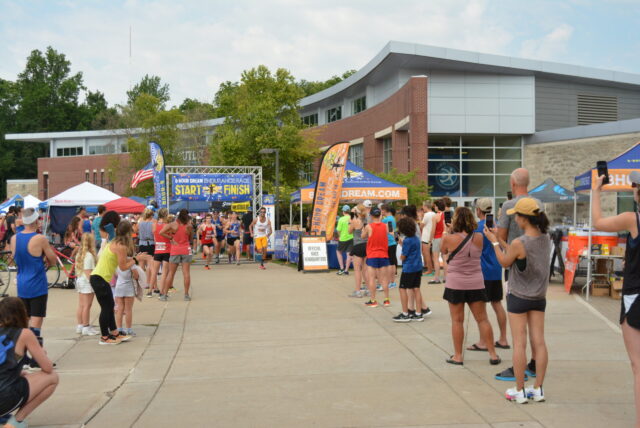For Marcel Altenburg, a leading crowd scientist at Manchester Metropolitan University, who’s worked with all the biggest sporting events in the world, the start of a race is the most important time of the whole day.
“It’s the last time I can impact the race,” he said.
What he means is that once the runners are out on course there’s only so much you, as a race director, can do to change their behavior or how they travel through the route. They’re going to run their own race. It’s like setting free hundreds or thousands of individual marbles and the last time you can point them in the right direction or influence their path is as you let them. go That’s why Altenburg’s team named their research project Start Right.
The principles of athlete flow
Altenburg is often contracted by the largest running races to study their event’s crowd behavior and create individualized algorithmic models for their specific race—meaning he is both out in the field measuring outcomes and running computer programs to test things like if a start corral is added or waves are separated by five minutes v. two minutes what happens farther down the course.
Most race directors, however, can’t afford these complex services. So, after four years of studying races as small as 500 people and as big as 50,000, he’s organized the research into five scientifically based principles that apply across all events, which he calls the golden rules of starting right.
1. Order your field by pace
Having the fastest runners at the front and the slower runners at the back of the start is the most important thing to organizing a start corral, because otherwise athletes can run into or over each other. It’s unpleasant for everyone. And any additional order is better—by which he means if it’s as simple as putting up pace signs up for a small race that’s good, and if you break a wave down into even more additional sections with signs that also helps even more.
2. Waves starts have a positive proven impact on race dynamics
This is a complement to rule #1 in that when a race is large enough (more than 1,000 athletes or so) establishing waves of athletes creates additional order to the chaos. Of course, athletes competing for podiums or front-of-the-race times will want to and should go head-to-head against each other, but in a larger race the rest of the field are likely expecting chip timing.
3. Waves should get smaller towards the back
It might seem counter-intuitive, but the research backs it up: If your race is big enough for waves, then the waves should get smaller as athletes get slower. Research shows it creates more space and a better flow at the finish line, helping to use fewer resources and eliminate crowding.
4. The start should be 30% narrower than the narrowest point within the first 2km
Again, this might sound counter-intuitive, but athletes need room to accelerate as they start running. They tend to crowd together before the start and then need space to move, run, and maneuver. If you have a sharp turn or a pinch point on course, especially in the first mile (2km = 1.2 miles), then the math shows you need to have a start line that’s about 30% narrower than that in order to create a steady stream instead of a deluge that’ll run into each other.
5. Start areas should not have more than three people per square meter
This becomes especially important, as is backed up in research on festivals and events, if there’s a safety issue. But even if there’s not, that’s about the maximum number of people you can fit in your start area when planning your route or course, whether it is small, medium or large.
Pre-race set-up
Of course, once you’re ready with these principles of start lines and athlete flow, then it’s time to design your start area—which can be as simple as a line on the ground and someone to blow a whistle (utilizing the rules above as they apply to your event) or you can string up ribbons to delineate zones and put up signage or it can involve barricades and an announcer.
If you’re contracting with a timing company (find insight on staffing your event here) —which almost all races will do at this point, since chip timing is relatively cheap—then work with them to know what kind of space they need for their start line timing mats and equipment. Then build backwards.
It’s almost always best to start with where your start line and that timing mat is going to be—per your official course plans—and then work in reverse: How far back will athletes line up depending on how many runners you’ll have? Then position port-a-potties and any amenities you’ll have (pre-race water, check-in or gear check, warm-up areas if necessary) farther back from there, and then parking should be planned farther back past that.
All of this, of course, depends on what specifically you have available, but it’s a good rule-of-thumb to have athletes flow coming in from the back—and you definitely want them entering any start area or corral from the back, not from in front of the start line.
“Always have it back-loaded instead of front-loaded,” said David Katz, who has been the official course measure for three Olympic Marathons, served on the USATF technical and rules committees, and currently sits on the World Athletics competition commission. ”It’s easier to bring people forward, then to push them back.”
Katz likes to have essentially have a “false” start line 10 meters behind the real one, so the race director or announcer can call them forward and, of course, clear out any little kids who have lined up in the front.
Good signage is also key. Especially since the vast majority of races don’t have athlete waves, then you need especially good pace signage in the line-up area (6:00min/mile, 7:00, 8:00, 9:00, etc.) to create that ordered start that’s key.
Katz also likes to make sure there’s a good announcer giving clear instructions. “You want to give good info, so people can prepare,” he said.
Pro tip: Katz suggests changing the voice on the mic a few minutes before the start, because athletes will adapt to the sound and start to tune out the announcer, so changing the voice will make them tune-in again.
And though it may sound obvious: you always, always want to start on time.
About the Author
 Kelly O’Mara is the former editor-in-chief of Triathlete Magazine and the founder of the Triathlonish
Kelly O’Mara is the former editor-in-chief of Triathlete Magazine and the founder of the Triathlonish

